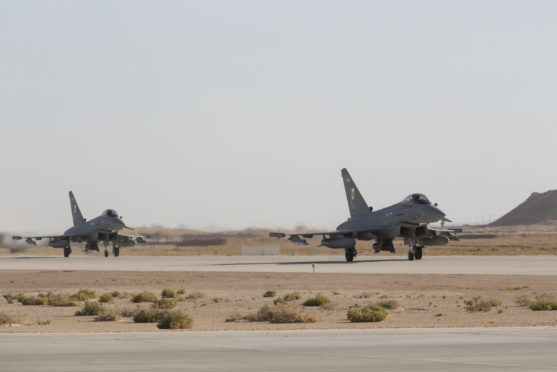Typhoons from RAF Lossiemouth have arrived in Oman to take part in a massive training exercise with the Middle East country’s Royal Air Force.
The operation will involve 4,500 UK military personnel and will also see the first deployment of British Army Challenger 2 main battle tanks and Warrior infantry fighting vehicles to a Gulf country since UK troops withdrew from Basra in Iraq in 2009.
The four aircrafts traveled to Thumrait Airbase in the south of the country following an overnight stop in Athens and will be joined by four more later this week.
They will fly alongside the Royal Air Force of Oman’s F-16 aircraft during the largest tri-service exercise in the region for almost two decades.
>> Keep up to date with the latest news with The P&J newsletter
The typhoons from RAF Lossiemouth’s II (Army Cooperation) Squadron are the first air component to arrive in Thumrait and will be followed by E-3D Sentry aircraft from RAF Waddington’s 8 Squadron.
All of these jets will take part in exercise SAIF SAREEA (Swift Sword) 3 as part of 140 Expeditionary Air Wing (EAW).
Squadron Leader Bruce McConnell, a II(AC) Squadron pilot, has been in Oman for two weeks preparing for the aircraft’s arrival.
He said: “It’s great to see the jets here safely. The engineering team have done a great job getting eight jets ready for the transit flight.
“Now the aircraft are here we can start to focus on the exercise. Everyone is looking forward to working alongside the Omani pilots and seeing what their aircraft can do.”
This is the third iteration of the exercise SAIF SAREEA and the first time it has been undertaken since 1987.
Group Captain Radnall, Commanding Officer of 140 EAW, has overall command of the RAF contingent at Thumrait and is looking forward to the exercise.
He said: “We have had personnel on the ground for a while now, setting up the life-support in advance of the Force Elements arrival. With the Typhoons now here, there is a real buzz about the place.
“This exercise has been a huge challenge logistically, but with so many elements working together in such close proximity, there is a real opportunity to learn individually and collectively.”
